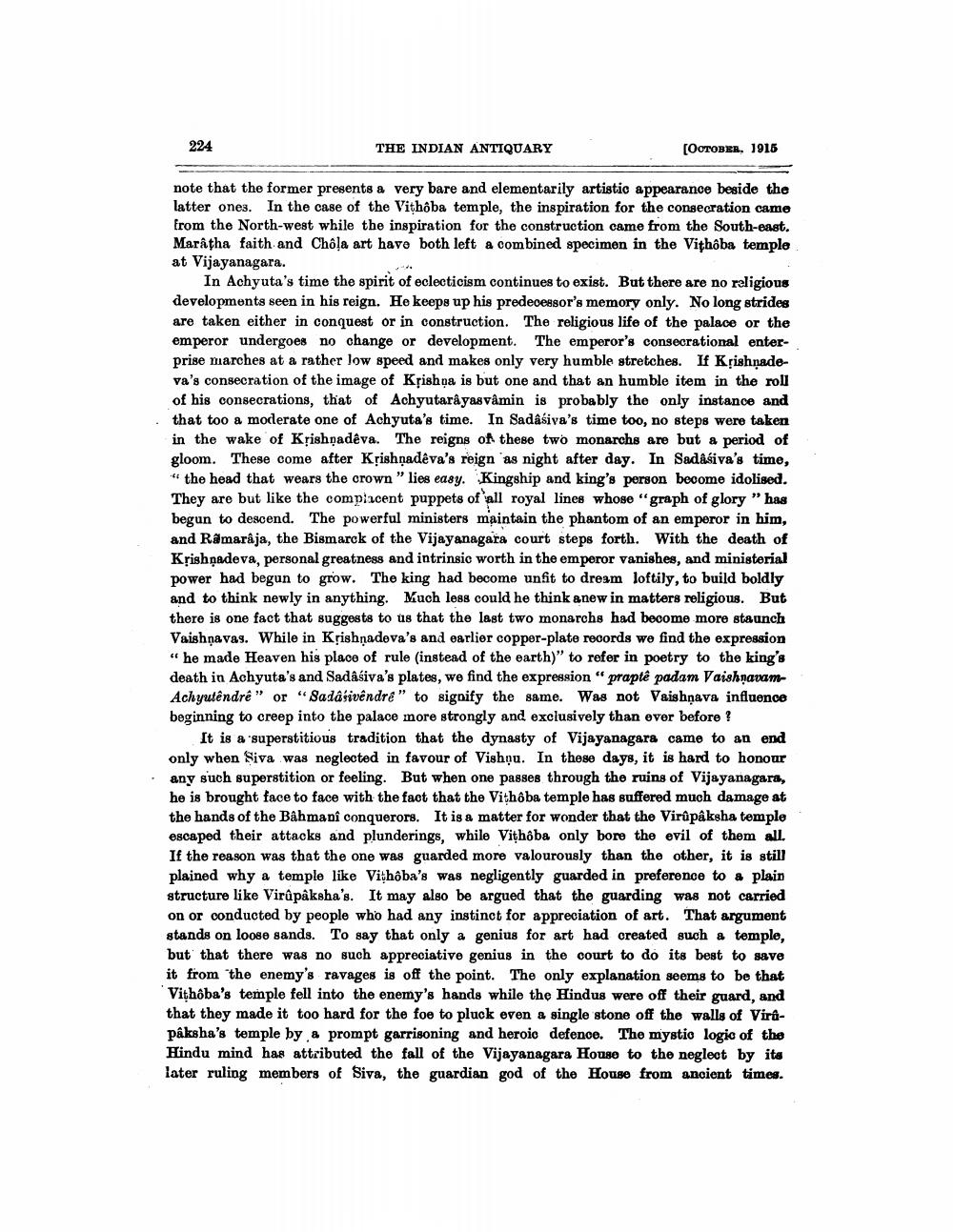________________
224
THE INDIAN ANTIQUARY
[OCTOBER, 1915
note that the former presents a very bare and elementarily artistic appearance beside the latter ones. In the case of the Viṭhôba temple, the inspiration for the consecration came from the North-west while the inspiration for the construction came from the South-east. Maratha faith and Chôla art have both left a combined specimen in the Vithôba temple at Vijayanagara.
In Achyuta's time the spirit of eclecticism continues to exist. But there are no religious developments seen in his reign. He keeps up his predecessor's memory only. No long strides are taken either in conquest or in construction. The religious life of the palace or the emperor undergoes no change or development. The emperor's consecrational enterprise marches at a rather low speed and makes only very humble stretches. If Krishnadeva's consecration of the image of Krishna is but one and that an humble item in the roll of his consecrations, that of Achyutarâyasvâmin is probably the only instance and that too a moderate one of Achyuta's time. In Sadasiva's time too, no steps were taken in the wake of Krishnadêva. The reigns of these two monarchs are but a period of gloom. These come after Krishnadêva's reign as night after day. In Sadasiva's time, "the head that wears the crown" lies easy. Kingship and king's person become idolised. They are but like the complacent puppets of all royal lines whose "graph of glory "has begun to descend. The powerful ministers maintain the phantom of an emperor in him, and Ramaraja, the Bismarck of the Vijayanagara court steps forth. With the death of Krishnadeva, personal greatness and intrinsic worth in the emperor vanishes, and ministerial power had begun to grow. The king had become unfit to dream loftily, to build boldly and to think newly in anything. Much less could he think anew in matters religious. But there is one fact that suggests to us that the last two monarchs had become more staunch Vaishnavas. While in Krishnadeva's and earlier copper-plate records we find the expression " he made Heaven his place of rule (instead of the earth)" to refer in poetry to the king's death in Achyuta's and Sadasiva's plates, we find the expression " praptê padam VaishnavamAchyutêndre" or "Sadasivêndre" to signify the same. Was not Vaishnava influence beginning to creep into the palace more strongly and exclusively than ever before?
It is a superstitious tradition that the dynasty of Vijayanagara came to an end only when Siva was neglected in favour of Vishnu. In these days, it is hard to honour any such superstition or feeling. But when one passes through the ruins of Vijayanagara, he is brought face to face with the fact that the Vithôba temple has suffered much damage at the hands of the Bâhmanî conquerors. It is a matter for wonder that the Virûpâksha temple escaped their attacks and plunderings, while Vithôba only bore the evil of them all. If the reason was that the one was guarded more valourously than the other, it is still plained why a temple like Vithoba's was negligently guarded in preference to a plain structure like Virûpâksha's. It may also be argued that the guarding was not carried on or conducted by people who had any instinct for appreciation of art. That argument stands on loose sands. To say that only a genius for art had created such a temple, but that there was no such appreciative genius in the court to do its best to save it from the enemy's ravages is off the point. The only explanation seems to be that Vithoba's temple fell into the enemy's hands while the Hindus were off their guard, and that they made it too hard for the foe to pluck even a single stone off the walls of Virâpâksha's temple by a prompt garrisoning and heroic defence. The mystic logic of the Hindu mind has attributed the fall of the Vijayanagara House to the neglect by its later ruling members of Siva, the guardian god of the House from ancient times.




